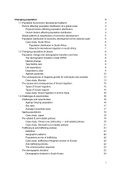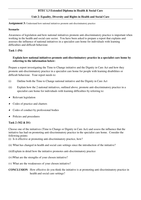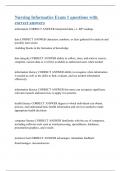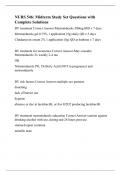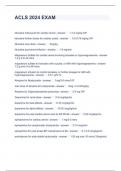Unit 7 Assignment 2. Forces in Sport and Exercise Activities
The college athletics coach has asked if I can do some work with the field athletes. A javelin thrower is
having difficulty throwing the javelin as far as they used to. The coach is concerned that their angle of
release of the javelin has altered which is the reason for this decrease in performance. A long jumper is
also not performing as well as they used to, and the coach thinks it may have something to do with not
producing sufficient force when they perform the jump by the bar. I have been asked to examine these
athletes’ performances and write a report which will be given to the coach.
Newton’s three laws and how they impact sports performance:
According to Newton's first law, unless influenced by an unbalanced force, an item at rest stays at rest,
and an object in motion keeps moving in a straight path at a constant pace. Inertia is the propensity to
resist changes in a condition of motion. There will not be any net force acting on the object if all the
external forces balance each other out. The item will maintain a constant velocity if there is no net force
exerted on it (NASA Glenn Research Center, 2022). One of the important ramifications for athletes is
that any extra mass will increase their inertia and prevent them from changing their speed and/or
direction quickly. Another example is the fact that a ball does not roll infinitely after being kicked.
However, since the ball experiences a net force as it comes to rest in the form of friction meaning that
its behaviour does not defy Newton's law. A golf ball serves as a last illustration because it will not move
unless a force is given to it by the golf club. Alternatively, unless a force acts to slow it down (such as
wind resistance) or reverse its trajectory (e.g., gravity), the identical golf ball will continue to go in the
same direction.
According to Newton’s second law, an object's acceleration is determined by its mass and the force
being applied. In accordance with his second law, a force is equal to the change in momentum (defined
as mass times velocity) per change in time. The mass of an object times its velocity is how momentum is
calculated (NASA Glenn Research Center, 2022). An example of this law would be that the larger the
weight an athlete can lift or the greater the vertical acceleration achieved on take-off for a high jump,
the more force is applied, the more acceleration is achieved. Tennis balls can move up to 160 mph
because the player's racket's acceleration enables them to be hit with the most force possible. Throwing
a football, baseball, and basketball are objects that are all subject to Newton's Second Law. A baseball
will accelerate far faster than a football if the same force is applied to both balls, everything else being
equal. This is due to the football's mass being more than three times that of baseball. The football
would, however, travel longer than the basketball if it were thrown with the same force since the
basketball weighs more than the football (Matthew, 2022).
According to Newton’s third law, every time one object applies force to another, the other object
applies an equal and opposing force to the first. His third law argues that there is an equal and opposite
reaction to every action (force) in nature. When object A pulls on item B, object B pulls back on object A
with an equal and opposing force. In other words, interactions lead to forces. An example is striking a
tennis ball. The ball experiences force from the racquet. This is the force of action. The racket
1
, experiences an equal and opposing force to that of the ball. The reaction force is this. The third law of
Newton describes how many sports injuries are brought on. Your arm experiences increased reaction
force from the racket as you strike the tennis ball with more force. When you are running, the ground
strikes your feet with an equal and opposing force each time (Motion and Forces: Newton’s Third Law of
Motion, 2022).
Stationary objects Striking objects Collision of objects
Unless a subsequent force acts Newton's Second Law states Forces act in pairs and are equal
on an object, Newton's first law that force is equal to its mass and opposite, as stated by
of motion states that it will times acceleration, or F = ma. A Newton's third rule of motion.
continue in its current state of football will travel farther and For instance, when two things
motion. If an item experiences faster with a forceful kick than bump into one another, the
no resulting force, then a one that is soft. The amount of forces applied by the two items
stationary object maintains its force behind the kick are equal and opposite. For
position. For example, a football determines how quickly the ball football, if a player kicks a
will stay at rest unless acted accelerates. moving football, the football
upon by an external force. will exert an equal and opposite
force on the football player.
Long jump:
A long jumper must overcome inertia (Newton’s first law) before the run up to begin running down the
track from where they are standing at the end of the runway. Once in motion, the jumper carries the
inertia along with them. When it is time to take off, another external force—this time from the show on
the ground—must override the inertia that is holding the jumper from changing direction as they sprint
down the runway. The jumper must land now that they are in the air. When their feet or body first
contact the ground, inertia is present in the form of an external force that causes the body to come to a
stop once more. A long jumper with an average build for an athletic college student would accelerate or
decelerate at a particular pace if a certain force were given to them. A smaller long jumper, on the other
hand, would be more affected by the force and would not produce as much force as a larger long
jumper would if the same force were applied to them. Smaller people will experience the effects more
severely, but merely because of their size, they will not be able to exert as much power. In other words,
the mass and acceleration of the other object directly affect the force an object creates and its impact
on it. In long jump, the athlete's feet are pressing down on the ground as they go into the moment of
take-off, and because of Newton's third law, the ground pushes back against them. This enables the
athlete to convert horizontal velocity into vertical velocity using their body. The athlete can shift some of
their velocity into the vertical direction by pushing off the ground and enabling the ground reaction
force to surpass that of the force their foot is applying to the ground (The Science of Long Jumping - the
Long Jump, n.d.).
Javelin:
2




